Grape picking: when and how to pinch the shoots
Unlike experienced gardeners (in particular, winegrowers), for novice summer residents, the grape pinching operation raises many questions. But thanks to the correct implementation of this procedure, you can increase the yield of your bushes, as well as get rid of some problems, especially fungal diseases due to thickening.
Next, let's talk about what grapes stepsons are, why and when they need to be removed (can they be left), as well as how to properly pinch grapes, what are the ways.
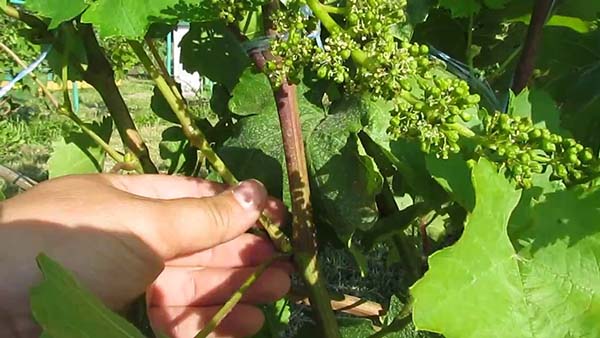
Content
Grape picking: what is it, when and why is it necessary
Stepchildren are additional shoots formed from the axils of the leaves (the so-called stepchildren or axillary shoots).
Note! A certain amount of stepson leaves is in any case necessary for a grape bush, since their photosynthetic ability is much higher than that of the main leaves of the shoots. The fact is that by the time the berries are poured and sugars are set by them, the main leaves become obsolete (especially the lower ones, therefore they are removed) and it is the stepsons who come to their aid.
Thus, the education of stepchildren is absolutely normal and completely natural phenomenoncharacteristic for the development of grape bushes.
The stepchildren themselves grow in different ways: depending on the variety, load, agricultural background, weather and other specific growing conditions.
However, it is believed that on the bushes, optimally loaded with shoots and crops, stepsons develop poorly... But their strong development testifies about underloading bushes.
Special active growth of stepchildren begins after fulfillment pinching procedures (before or only at the beginning of flowering) and summer coinage grapes.
Advice! About, what is pinching and chasing grapes, detailed in this article.

Unfortunately, not everyone understands why grapes are pinched.
The fact is that the extra stepsons take away strength and nutrition at the plant, as well shade the bushes themselves (due to poor ventilation, grapes can easily pick up one of the fungal diseases -oidium or mildew)
Lots of leaves are good for feeding grapes, but only if they are normally lit. If they shade each other due to excessive thickening of the bush with the same stepson shoots and leaves, then the leaves simply do not work (their photosynthesis is minimal).
Respectively, occasionally (already from the end of spring during the summer, as new stepchildren grow), you need to get rid of them (pinch the grapes), i.e. remove stepsons - pinch with hands (nails) or cut with pruning shears.
Important! If you are going to carry out the procedure summer coinage, then you will have to leave a lot of stepson leaves in order to gain the required number of leaves for good ripening of the bunches (remember that 1 kg of grapes requires an average of 25 leaves).
By the way! For this, the 2nd and 3rd methods of pinching are optimal.
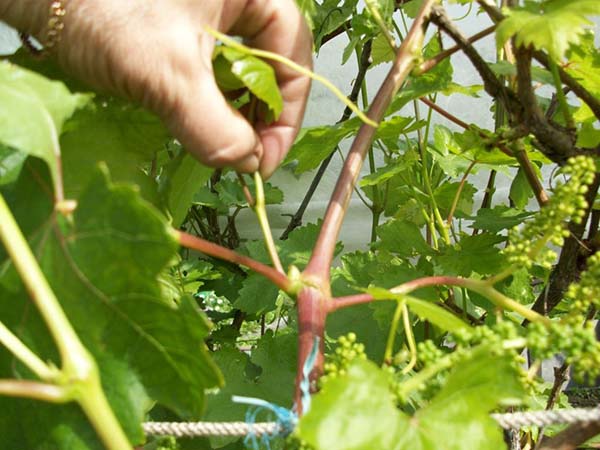
Interesting opinion! The stepsons must be removed when they are not yet lignified, i.e. green. At this time, they break well, do not injure the main vine, and this work, as a rule, coincides with another garter of growing green vines to the trellis wire... In this case, the stepsons do not grow back again, the grapes do not overgrow and the appearance of diseases due to its thickening is minimized.
How to pinch grapes correctly: pinching methods
Now let's move on to the most important question of how to properly pinch grapes.
Very often, novice growers completely remove stepchildren, breaking them right at the base. Firstly, as you already found out earlier, you cannot delete all the stepsons, and secondly, it is also worth considering one very important point.
Interesting! The fact is that in the axil of the leaf, together with the stepson, an eye is also formed (there are several buds in it: central and lateral), which will have to give a new fruitful shoot next year. If you break this stepson, then the central kidney in this eye (the strongest one) will wake up and start growing this year (and the weaker ones, the lateral ones, will wake up next year).
Thus, when you pinch a stepson's shoot, it becomes, as it were, a "watchman" for the eye, in other words, it simply does not allow the central bud to bloom this year.
Logical question: Why bother about the safety of wintering buds, if the fruiting vine will still be cut off (removed) all, up to the replacement knot?
The logical answer: in this case there is no need, but:
- firstly, as a rule, not all of the fruiting vine is cut off, some will be left, which means that a certain number of wintering buds must be preserved.
By the way! The site already has an article about how to properly prune grapes in autumn, after reading which you will understand the structure of grapes and understand exactly what shoots you need to leave for next year.
- secondly, part of the vine will go for the autumn harvesting of cuttings.
So you you can completely break the stepsons, but it's worth understandingthat after a while (after 10 days) a new stepson from the central kidney is formed in the same place, which means that you will have to repeat the procedure.
Next, we will consider different ways to correctly pinch grapes.
Advice! Always remember the principle: the larger the total area of well-lit leaves, the more organic matter they synthesize. However, if the leaves on the stepsons interfere with something, for example, lighting, airing, ease of use, etc., then they must be removed.
1 way of pinning (classic)
The essence of the classic way of pinching grapes is as follows:
- All upper stepchildren that grow above the bunches should be pinched after 2 sheets (if second-order stepchildren are formed, they will need to be completely plucked out).
Interesting! Sometimes you can come across the opinion that you need to leave only 2 sheets, i.e. 1 main leaf and 1 on the stepchild's shoot, and sometimes 3 leaves, i.e. 2 on the stepson and 1 on the main shoot.
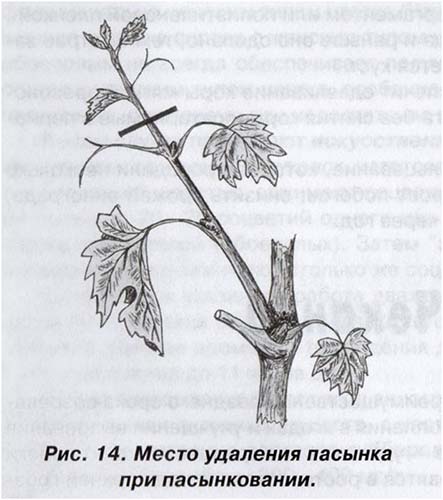
- All lower stepchildren that grow below the bunches need to be broken out completely, or a maximum of 1 sheet should be left (if second-order stepchildren are formed, they will also need to be completely plucked out).
Video: pinching grape bushes
2 way of pinching (leaving 1 sheet for stepchildren of the 2nd, 3rd and 4th order)
Note! If the first method implies that two stepsons and the rest of the main leaves will be quite enough, then the following 2 methods aim to leave as many leaves as possible, i.e. in this case, the small length of the main vine is compensated by additional stepchildren for 2-4 leaves, for example, when summer coinage to the level (height) of the trellis (i.e. slightly higher - to where the hand reaches).
The meaning of this method of pinching grapes is as follows:
- Give the stepchild's grape shoots to grow a little, and then cut it, leaving 1 leaf on each stepson.
However, it is believed that 2-4 leaves work productively (for better yield) on one shoot, and we left only one leaf. What to do?
- As you understood, stepson shoots will always form in the bosom of each leaf, in other words, another new stepson will also form from the bosom of your left one leaf, which is already called the second order stepson.
The logic is as follows: from the bosom of the sheet of the stepson of the second order, the stepson of the third order is formed, and from him the fourth. Thus, you should leave 1 sheet for each stepchild (pinch above it). As a result, by the end of the growing season, you will have 2-4 productive leaves.
The essence of this method of pinning is shown in the picture below:
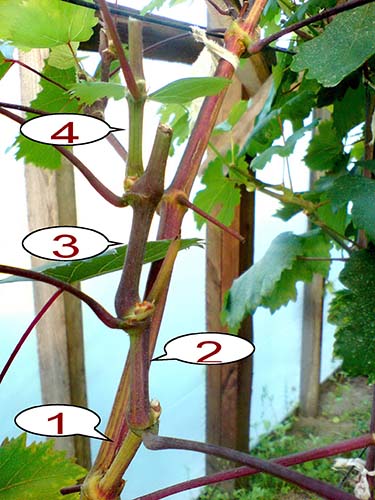
3 way of pinching (leaving the stepson with 2-4 leaves)
You can immediately leave on each stepchild of the first order 2-4 sheets, i.e. initially let it grow, and then pinch after 2-4 leaves.
Logical question: "And what to do with stepchildren of the 2nd order, which will inevitably form from the axils of the leaves left?"
The logical answer: "You need to always maintain a constant number of leaves, so there may be the following options for subsequent pinching":
- when the necessary 2-4 sheets are formed on the stepchildren of the second order, you can simply pinch them above them, in the end you will have 2-4 sheets, with 1-3 new ones;
- or during subsequent pinching, you can not update the leaves at the expense of second-order stepchildren, but simply completely break out everything that will appear on the first stepchild, since you still do not need to save any eyes for the next year.
What are the advantages of this method of pinching grapes:
- less work, you do not need to often do pinching (this is especially true if you have a lot of bushes);
- bushes always have a constant large leaf area, in contrast to the first method, when the number of leaves increases gradually.
Advice! For the lower stepchildren, which grow up to grape clusters, it is better to leave 1 sheet, and just above the brush - 2 leaves on each stepchild, then 3-4 leaves.
It is better to remove the stepchildren below and next to the bunch not immediately, but later, when all growth processes shift to the upper tier, i.e. the berries begin to gain color and ripen.
For what? So that the clusters are better illuminated, and the bushes in general are well ventilated.
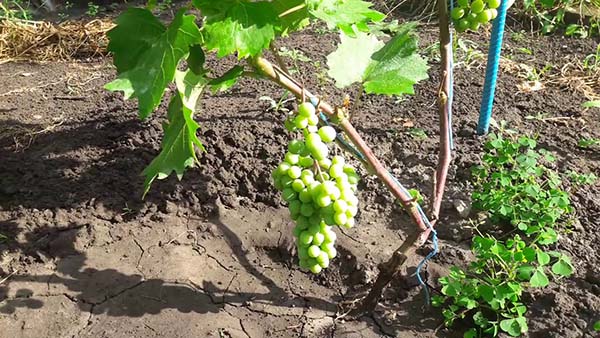
Video: how to pinch grapes
What to do with circumcised stepchildren
All circumcised stepchildren should not be left in the vineyard, much less thrown on the ground (in its near-trunk circle). The fact is that various fungi and infections can be found on the leaves, therefore, all shoots cut off during pinching must be completely disposed of, i.e. take out (take out) from the site or burn.
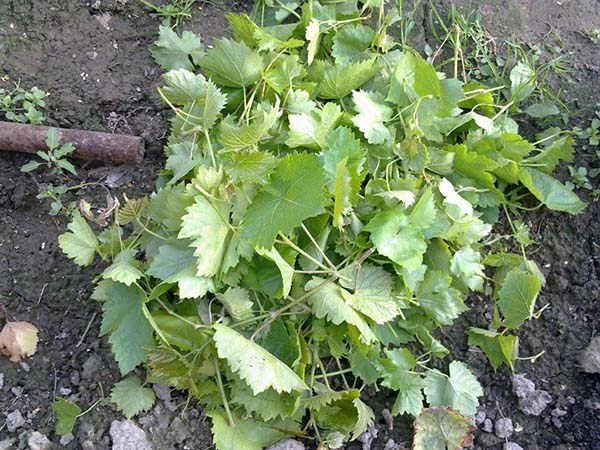
Is it possible not to remove stepchildren from grapes or how to get a stepson's harvest
Many novice growers who do not at all stepchildren of their grapes are faced with the fact that inflorescences are formed on the stepsons = future bunches.
However, it should be understood that in non-southern regions getting a stepchild's harvest will be problematic... Therefore, you need to independently remove (cut off) the inflorescences on the stepchildren, since they will take food from the bunches on the main shoots, delaying their ripening, and, most dangerous, you are not threatened with ripening shoots, but not ripe shoots - this is a potentially frozen bush in winter ...
So, you can get an additional small crop on stepchildren in the following cases:
- in a warm (southern) climate;
- on very early varieties;
- if the bush is underloaded with harvest.
However! In cooler regions, it is better to remove inflorescences on stepchildren immediately, especially on medium and late varieties.

Thus, pinching grapes is a mandatory procedure for the correct cultivation of this berry culture. And which way it is more convenient for you to remove stepchildren is up to you, just try different ones and choose the most convenient and productive one for you, while taking into account the need for a certain number of leaves for the ripening of the crop.
Video: what stepsons to leave on grapes

